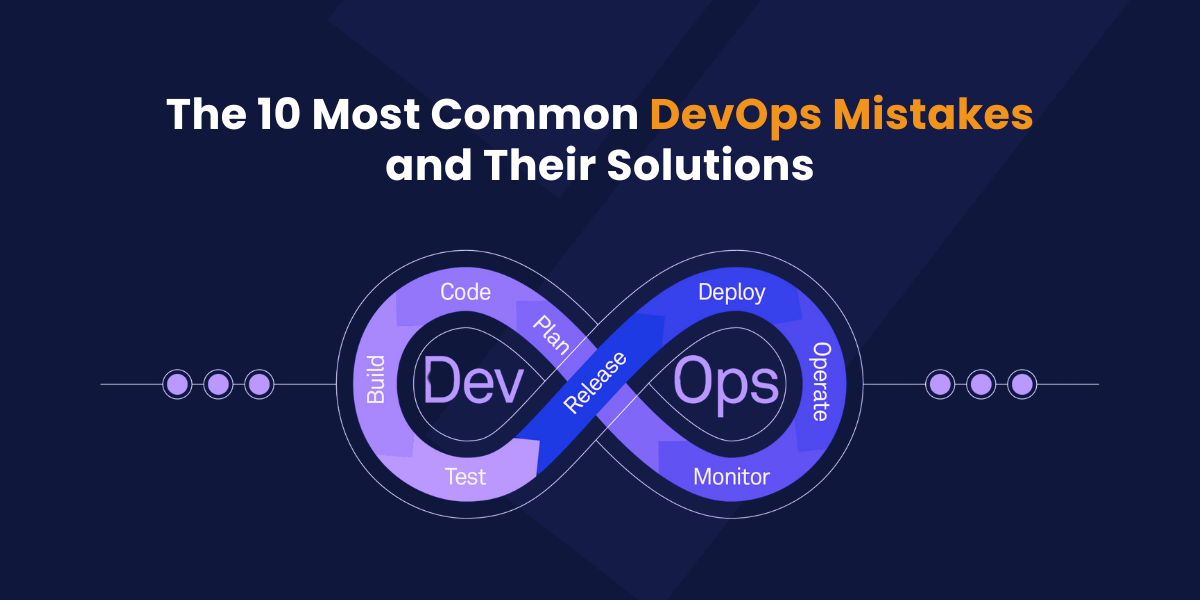The 10 Most Common DevOps Mistakes and Their Solutions
DevOps, a combination of “development” and “operations,” has become a transformative approach in the software development lifecycle. It promises faster time to market, improved collaboration between IT and operations teams, and enhanced product quality. As organizations increasingly adopt DevOps, they encounter both benefits and challenges. This article explores ten significant DevOps mistakes and how to avoid them, providing insights for smoother implementation and better results.
1. Dev and Ops Teams Don't Communicate
Mistake: Despite the core goal of fostering better collaboration and communication, many organizations struggle to break down the traditional silos between development and operations teams. This lack of communication can lead to misunderstandings, inefficiencies, and delayed deployments.
Solution: Implement cross-functional teams that include members from both development and operations. Ensure these teams participate in all stages of the product lifecycle, from planning to deployment. Encourage regular meetings and transparent communication to create a cohesive workflow. Training on soft skills such as communication and collaboration is also crucial.
2. Cybersecurity is an Afterthought
Mistake: In the rush to deploy new features, security checks are often overlooked, increasing the risk of vulnerabilities and breaches. This can be particularly detrimental in industries with strict regulatory requirements, such as healthcare and finance.
Solution: Integrate security into every stage of the CI/CD pipeline. Use automated security tools to conduct real-time assessments and continuous vulnerability scanning. Make security a fundamental part of the DevOps process rather than an afterthought. Educate teams on security best practices and ensure compliance with industry standards.
3. Complex IT Infrastructure Doesn't Scale
Mistake: Modern IT infrastructures can be highly complex, especially with the rise of remote work, cloud resources, and mobile devices. This complexity can hinder the scalability and performance of DevOps practices.
Solution: Invest in training for advanced cloud infrastructure and services, focusing on Infrastructure as a Service (IaaS) and Platform as a Service (PaaS). Develop a strategy for managing and scaling these environments efficiently without compromising performance or security. Consider using automation tools to handle routine tasks and maintain scalability.
4. DevOps Priorities Don't Match Business Goal
Mistake: Misalignment between DevOps initiatives and overall business objectives can lead to wasted resources and unmet goals. Rapid development cycles may not always align with strategic business priorities.
Solution: Regularly convene cross-functional teams to review DevOps strategies in the context of current business goals. Ensure that IT initiatives support the overall company direction. Use metrics and KPIs that reflect both DevOps performance and business outcomes to track progress and make necessary adjustments.
5. New Technologies Break the DevOps Workflow
Mistake: The eagerness to adopt the latest technologies can introduce complexity and disrupt established workflows. New tools may require significant learning curves and may not integrate seamlessly with existing systems.
Solution: Adopt a “proof of concept” approach before fully integrating new technologies. Conduct small-scale trials to assess their impact and efficacy. Ensure new tools positively contribute to processes without adding undue complexity or reducing efficiency. Involve team members in the evaluation process to gain diverse perspectives.
6. Old Technologies Break the DevOps Workflow
Mistake: Legacy systems often lack the agility needed for a seamless DevOps pipeline, creating bottlenecks and integration challenges.
Solution: Focus on incremental modernization. Use application programming interfaces (APIs) to wrap legacy systems, exposing their functionality to newer, DevOps-friendly interfaces. This approach preserves essential functions while streamlining operations. Gradually replace outdated systems with modern alternatives to enhance overall efficiency.
7. Cultural Resistance Slows DevOps Adoption
Mistake: Transitioning from traditional siloed teams to an integrated DevOps approach can meet resistance from team members who are accustomed to established ways of working.
Solution: Foster a culture of continuous learning and collaboration. Create an environment where feedback is valued, and failures are seen as learning opportunities. Implement comprehensive training programs and establish clear communication channels to help team members understand the benefits of DevOps practices. Celebrate small successes to reinforce positive changes.
8. Remote Work Slows DevOps Collaboration
Mistake: The shift to remote or hybrid work models can disrupt communication and collaboration, critical components of a successful DevOps strategy.
Solution: Establish robust remote work policies and embrace collaboration tools and platforms. Regular virtual check-ins, clear documentation of processes, and progress tracking can help maintain cohesion and productivity among remote teams. Foster a culture of trust and autonomy to ensure remote employees remain aligned with organizational goals.
9. Dev and Ops Want Different Things
Mistake: Development teams often prioritize rapid changes and innovation, while operations teams focus on stability and reliability. This divergence can lead to conflicts and slow down the DevOps process.
Solution: Instill a culture of shared responsibility, where both teams work together from project initiation to final implementation. Encourage open communication and mutual understanding of each team’s goals and challenges. Implement shared goals and performance metrics to align their efforts.
10. Automation Doesn't Solve Everything
Mistake: While automation is a cornerstone of DevOps, attempting to automate every process can lead to inefficiencies and overlooked complexities.
Solution: Identify and target the right processes for automation. Focus on areas where automation can genuinely save time and resources. Understand that automation should complement, not replace, human expertise. Continuously evaluate automated processes to ensure they remain effective and make adjustments as needed.
Conclusion
DevOps offers significant benefits, including faster time to market, improved collaboration, and enhanced product quality. However, its implementation is not without challenges. By avoiding these common mistakes and adopting best practices, organizations can ensure a smoother DevOps journey and achieve their strategic goals. Continuous learning, communication, and alignment with business objectives are key to maximizing the potential of DevOps.

